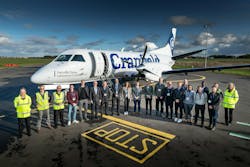U.K. demonstrates its first successful satnav overlay
LONDON - Viasat in Carlsbad, California announced the successful first demonstration of a United Kingdom satellite-based augmentation system (UK SBAS). The UK is no longer part of the EU's similar European Geostationary Navigation Overlay Service (EGNOS), following its exit from the European Union. While EGNOS can still be used for non-safety applications in the UK, the trial aims to provide a first step toward a complementary UK SBAS which can be used for critical safety of life navigation services across air, land, and sea.
UK SBAS works by combining ground monitoring data with satellite connectivity to provide more reliable navigational data. Across a range of applications, it can offer positioning down to a few centimeters of accuracy, rather than the few meters provided by standard GPS. For aviation, the system gives pilots greater trust in their onboard instruments, which has major implications when pilots may not be able to physically see a runway or other obstacles due to bad weather.
This means improved safety and fewer missed landings because pilots – especially smaller aircraft flying into regional airports and general aviation airfields – can get significantly closer to the ground during an approach before deciding whether to land. Viasat's research with one regional flight operator indicated that close to 40% of flights canceled due to weather could have gone ahead had UK SBAS been available for its fleet. Around the UK, 19 airports had EGNOS procedures in place before leaving the European Union. In total, as many as 72 airports no longer have access.
With the aviation test complete, the trial is aimed to test the system in other transport applications, for example for rail, uncrewed aerial vehicles, or autonomous road vehicles.
UK SBAS generates an overlay test signal to the US Global Positioning System (GPS), fully compliant with International Civil Aviation Organization (ICAO) standards, to enable assessment of more precise, resilient, and high-integrity navigation for maritime and aviation users in UK waters and airspace. The signal is being broadcast in coordination with the US Federal Aviation Administration (FAA), the European Space Agency (ESA), and the European Union Space Program Agency (EUSPA). Broadcast capability for UK SBAS is being provided by Viasat's I-3 F5 satellite.
A similar system, known as SouthPAN, is currently being developed to make resilient positioning, navigation and timing (PNT) available in Australia and New Zealand. Signals for the service would be provided by Viasat through one of its next-generation I-8 satellites, which are aimed to launch in 2027.
Technology Minister at the Department for Transport, Anthony Browne said "This successful demonstration illustrates the UK's first-class space sector, and our capabilities in position, navigation and timing specifically."
"The project, fully funded by Government through the ESA NAVISP program, is directly supporting our work on future provision of high-accuracy, high-integrity positioning services, which could increase efficiency and enable new innovations across the transport network."
